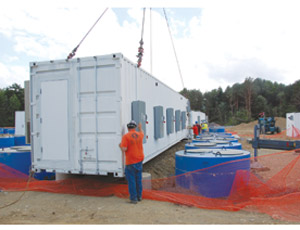When finished in 2011, a flat 3½ -acre piece of land with 20 shipping containers on concrete pads in upstate New York won’t hint at the complexity underneath: 200 flywheel storage devices spinning at Mach 2 to retain and release up to 20 MW of energy on a second-to-second basis.

Tyngsboro, Mass.-based Beacon Power is developing this first-of-a-kind energy storage facility in Stephentown, N.Y., one of several energy-storage projects that got a push forward from grants, loan guarantees and tax credits made available through the American Recovery and Reinvestment Act. On Aug. 9, the Dept. of Energy approved a $43-million loan guarantee for the $69-million Beacon project. A second 20-MW Beacon Power project, to be built in either Chicago or Pennsylvania, has received a $24-million smart-grid stimulus grant. Beacon also is developing a third flywheel facility in Glenville, N.Y.
Furthermore, DOE is supporting the development of battery storage. In August, DOE gave Arlington, Va.-based AES Energy Storage a $17.1-million loan guarantee for a 20-MW lithium-ion battery facility in Johnson City, N.Y.
Interest in technologies that could store excess renewable energy, prevent blackouts and reduce the need for new transmission lines peaked about 18 months ago, just as Congress was considering funding opportunities for the American Recovery and Reinvestment Act. “Everything came together at once like a perfect storm,” said Georgianne Huff, a researcher at the Sandia National Laboratories in Albuquerque, N.M.
Energy storage can be used to smooth out the delivery of energy on a short-term basis or to store energy to use later. The AES and Beacon projects are for short-term energy storage. Both Beacon and AES will provide a regulating service that typically is performed by natural-gas plants that are ramped up and down to smooth the delivery of power.
Beacon’s flywheels are rotors that act as mechanical batteries, spinning up to 16,000 rpm to store electricity. When the grid needs electricity, the rotors turn into generators and release the stored power.
Beacon’s Stephentown facility will consist of 200 six-ft-tall and 3-ft-diam flywheels encased in concrete, lowered into an eight-ft trench and placed on a concrete pad. Ten flywheels are able to regulate 1 MW. For every 10 flywheels, a 48-ft shipping container is placed on the surface to cover the cooling pipes and connections for the flywheels.
Pasadena, Calif.-based Jacobs Engineering designed the plant, and LeChase Construction, Rochester, N.Y., is building the facility. The first 4 MW of the Stephentown plant will come online later this year, and the entire system will be operational in the first quarter of 2011.
Construction largely entails digging eight-ft-deep trenches, backfilling over the flywheel cylinders, laying pipe and pouring the necessary concrete footings and pads, said Gene Hunt, a spokesman for Beacon. A contractor for Beacon’s other plants has not been selected, he said.

Post a comment to this article
Report Abusive Comment